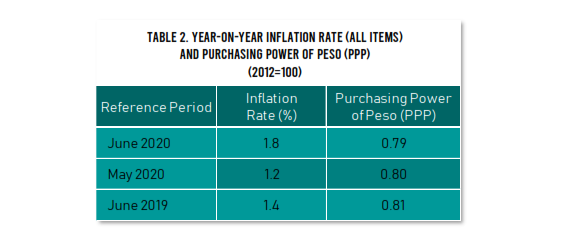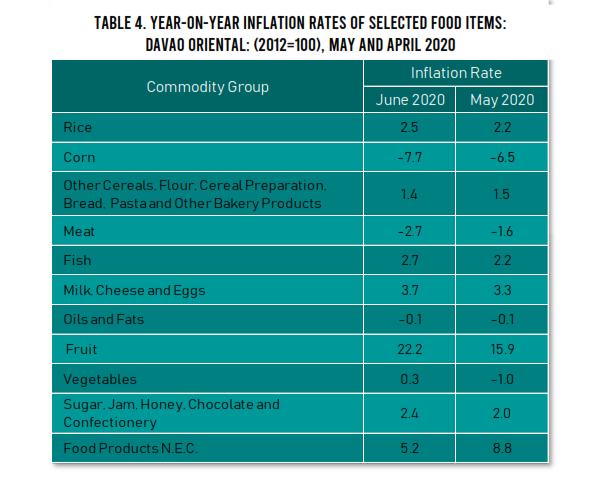 Davao Oriental’s CPI is at 126.0 in June 2020
Davao Oriental’s CPI is at 126.0 in June 2020
Price indices are used for economic analysis and as a monitoring indicator of government’s economic policy. The Consumer Price Index (CPI) is most widely used in the calculation of the inflation rate and purchasing power of peso. The CPI is an indicator of the changes in the average retail prices of a fixed basket of goods and services commonly purchased by households relative to a base year.
Survey of Retail Prices of Commodities conducted by Philippine Statistics Authority (PSA) has generated a CPI of 126.0 as of June 2020, using 2012 as the base year. This means that for a typical Filipino household in Davao Oriental to afford same values of goods and services purchased or availed in June 2012 at PhP100.00, needs an additional PhP26.00 in June 2020. The CPI in May 2020 was lower at 125.5. In June 2019, the CPI was at 123.8.
In June 2020, the CPI of the following commodity groups increased compared with its previous month’s CPI: Transport (102.4), Alcoholic Beverages and Tobacco (188.6), Clothing and Footwear (165.4), Housing, Water, Electricity, Gas and Other Fuels (119.1), Health (131.6), Furnishings, Household Equipment and Maintenance of the House (138.4) and Recreation and Culture (127.7).
On the other hand, the computed CPIs of the following commodity groups remained the same: Restaurant and Miscellaneous Services (130.9), Food and Non-Alcoholic Beverages (127.3), Communication (101.5) and Education (95.7).

Davao Oriental’s inflation rate rise to 1.8 percent in June 2020
Inflation Rate is the annual rate of change or the year change of the CPI expressed in percent. Inflation is interpreted in terms of declining purchasing power of money.
The year-on-year inflation rate in Davao Oriental accelerated to 1.8 percent in June 2020 from 1.2 percent in the previous month. During the same month in 2019, inflation rate was lower at 1.4 percent.
This implies that if you paid PhP15.00 for a can of sardines in June 2019 and if on the average, prices went up by 1.8 percent after a year's time, you will need PhP15.27 to buy same brand of a can of sardines in June 2020. See Table 2.

The increase in the inflation rate during the month was mainly driven by the higher annual rate in the indices of Alcoholic Beverages and Tobacco (12.0%); Housing, Water, Electricity, Gas and Other Fuels at Restaurant and Miscellaneous Goods and Services (1.1%) and Clothing and Footwear (1.1%). The heavily weighted commodity group of Food and Non-Alcoholic Beverages (1.4%) also increased during the period
Meanwhile, slower annual mark-ups were seen in the indices of the Health (3.7%), Transport (-0.9%) and Furnishings, Household Equipment and Maintenance of the House (1.2%). The year-on-year inflation rate of education was 0 percent.

.
The indices of the rest of the commodity groups such as Restaurant and Miscellaneous Goods & Services, Communication and Recreation and Culture retained their previous month’s annual growth rates. See Table 3.
On food index, the annual rate at the provincial level went up to 1.4 percent in June 2020, from 1.2 percent in the previous month. The increase was mainly due to the increase in the annual rate of Fruit (22.2%), Vegetables (0.3%), Fish (2.7%), Milk, Cheese and Eggs (3.7%), Sugar, Jam, Honey, Chocolate and Confectionery (2.4%) and Rice (2.5%)
The annual growth rates, however, went down in the indices of Other Cereals, Flour, Cereal Preparation, Bread, Pasta and Other Bakery Products (1.4%), Meat (-2.7%), Corn (-7.7%) and Food Products NEC (5.2%). Oils and Fats retained its annual rate. See Table 4.

The PPP in June 2020 declined to 79 centavos from PPP of 80 centavos recorded in the previous month. This implies that Php1.0 in June 2012, as the base year, values only Php0.79 in June 2020. In June 2019, the PPP was at 81 centavos.
Approved for Release:
ROGELIO T. LEBRIA
Chief Statistical Specialist
TECHNICAL NOTES
Uses of CPI
The CPI is most widely used in the calculation of the inflation rate and purchasing power of peso. It is a major statistical series used for economic analysis and as a monitoring indicator of government economic policy.
Computation of CPI
The computation of the CPI involves consideration of the following important points:
a. Base Period - The reference date or base period is the benchmark or reference date or period at which the index is taken as equal to 100.
b. Market Basket - A sample of the thousands of varieties of goods purchased for consumption and services availed by the households in the country selected to represent the composite price behavior of all goods and services purchased by consumers.
c. Weighting System - The weighting pattern uses the expenditures on various consumer items purchased by households as a proportion to total expenditure.
d. Formula - The formula used in computing the CPI is the weighted arithmetic mean of price relatives, the Laspeyre’s formula with a fixed base year period (2006) weights.
e. Geographic Coverage - CPI values are computed at the national, regional, and provincial levels, and for selected cities.
